
Nathan Lane is an American actor. In a career spanning over 40 years he has been seen on stage and screen in roles both comedic and dramatic. Lane has received numerous awards including three Tony Awards, an Olivier Award, three Emmy Awards, a Screen Actors Guild Award and a People's Choice Award. In 2006, Lane received a star on the Hollywood Walk of Fame, and was inducted into the American Theater Hall of Fame in 2008. In 2010, The New York Times hailed Lane as "the greatest stage entertainer of the decade".

The Winter Garden Theatre is a Broadway theatre at 1634 Broadway in the Midtown Manhattan neighborhood of New York City. It opened in 1911 under designs by architect William Albert Swasey. The Winter Garden's current design dates to 1922, when it was completely remodeled by Herbert J. Krapp. Due to the size of its auditorium, stage, and backstage facilities, it is favored for large musical productions. It has 1,600 seats and is operated by The Shubert Organization. The auditorium interior is a New York City landmark.
The Obie Awards or Off-Broadway Theater Awards are annual awards originally given by The Village Voice newspaper to theatre artists and groups in New York City. In September 2014, the awards were jointly presented and administered with the American Theatre Wing. As the Tony Awards cover Broadway productions, the Obie Awards cover off-Broadway and off-off-Broadway productions.
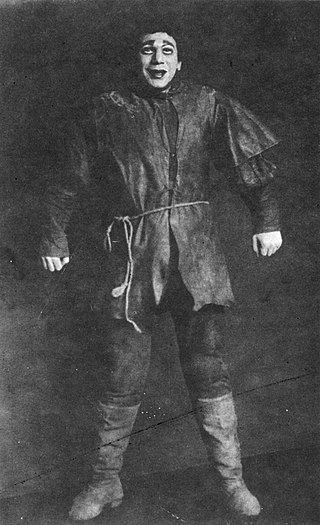
The Golem is a 1921 "dramatic poem in eight scenes" by H. Leivick. The story is a reworking of a legend of Judah Loew ben Bezalel, known as the Maharal, a great rabbi of Prague. In the legend, he animates a golem, a being crafted from inanimate material. The same legends had provided the ground for Gustav Meyrink's 1915 novel of the same name.

The Bernard B. Jacobs Theatre is a Broadway theater at 242 West 45th Street in the Theater District of Midtown Manhattan in New York City. Opened in 1927, the theater was designed by Herbert J. Krapp in a Spanish style and was built for real-estate developer Irwin S. Chanin. It has 1,100 seats across two levels and is operated by The Shubert Organization. Both the facade and the auditorium interior are New York City landmarks.
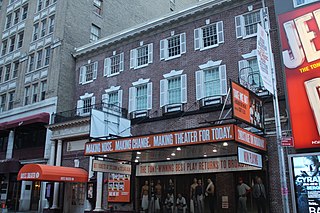
The Hayes Theater is a Broadway theater at 240 West 44th Street in the Theater District of Midtown Manhattan in New York City. Named for actress Helen Hayes, the venue is operated by Second Stage Theater. It is the smallest Broadway theater, with 597 seats across two levels. The theater was constructed in 1912 for impresario Winthrop Ames and designed by Ingalls & Hoffman in a neo-Georgian style. The original single-level, 299-seat configuration was modified in 1920, when Herbert J. Krapp added a balcony. The theater has served as a legitimate playhouse, a conference hall, and a broadcasting studio throughout its history.

The Shubert Theatre is a Broadway theater at 225 West 44th Street in the Theater District of Midtown Manhattan in New York City. Opened in 1913, the theater was designed by Henry Beaumont Herts in the Italian Renaissance style and was built for the Shubert brothers. Lee and J. J. Shubert had named the theater in memory of their brother Sam S. Shubert, who died in an accident several years before the theater's opening. It has 1,502 seats across three levels and is operated by The Shubert Organization. The facade and interior are New York City landmarks.
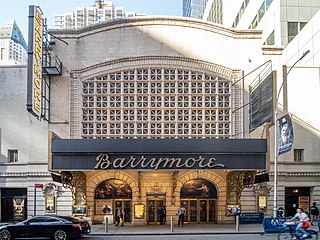
The Ethel Barrymore Theatre is a Broadway theater at 241 West 47th Street in the Theater District of Midtown Manhattan in New York City. Opened in 1928, it was designed by Herbert J. Krapp in the Elizabethan, Mediterranean, and Adam styles for the Shubert family. The theater, named in honor of actress Ethel Barrymore, has 1,058 seats and is operated by the Shubert Organization. Both the facade and the auditorium interior are New York City landmarks.

The John Golden Theatre, formerly the Theatre Masque and Masque Theater, is a Broadway theater at 252 West 45th Street in the Theater District of Midtown Manhattan in New York City. Opened in 1927, the Golden Theatre was designed by Herbert J. Krapp in a Spanish style and was built for real-estate developer Irwin S. Chanin. It has 800 seats across two levels and is operated by The Shubert Organization. Both the facade and the auditorium interior are New York City landmarks.

The Broadhurst Theatre is a Broadway theater at 235 West 44th Street in the Theater District of Midtown Manhattan in New York City. Opened in 1917, the theater was designed by Herbert J. Krapp and was built for the Shubert brothers. The Broadhurst Theatre is named for British-American theatrical producer George Broadhurst, who leased the theater before its opening. It has 1,218 seats across two levels and is operated by The Shubert Organization. Both the facade and the auditorium interior are New York City landmarks.
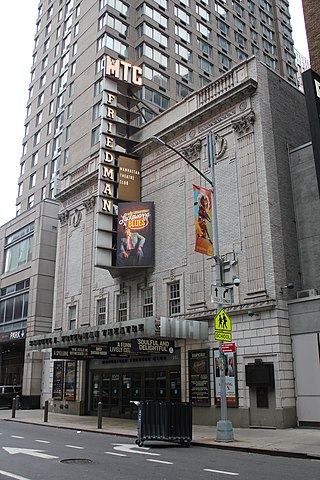
The Samuel J. Friedman Theatre, formerly the Biltmore Theatre, is a Broadway theater at 261 West 47th Street in the Theater District of Midtown Manhattan in New York City. Opened in 1925, it was designed by Herbert J. Krapp in the neo-Renaissance style and was constructed for Irwin Chanin. It has 650 seats across two levels and is operated by the Manhattan Theatre Club (MTC). The auditorium interior is a New York City landmark, and the theater is listed on the National Register of Historic Places. Since 2008, the theater has been named for Broadway publicist Samuel J. Friedman, whose family was a major donor to MTC.

The Belasco Theatre is a Broadway theater at 111 West 44th Street, between Seventh Avenue and Sixth Avenue, in the Theater District of Midtown Manhattan in New York City. Originally known as the Stuyvesant Theatre, it was built in 1907 and designed by architect George Keister for impresario David Belasco. The Belasco Theatre has 1,016 seats across three levels and has been operated by The Shubert Organization since 1948. Both the facade and interior of the theater are New York City landmarks.
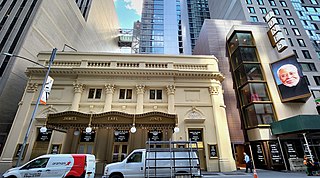
The James Earl Jones Theatre, originally the Cort Theatre, is a Broadway theater at 138 West 48th Street, between Seventh Avenue and Sixth Avenue, in the Theater District of Midtown Manhattan in New York City, United States. It was built in 1912 and designed by architect Thomas W. Lamb for impresario John Cort. An annex to the west of the theater, built between 2021 and 2022, was designed by Kostow Greenwood Architects. The Jones has 1,092 seats across three levels and is operated by the Shubert Organization. Both the facade and interior of the theater are New York City designated landmarks.

Raúl Eduardo Esparza is a Cuban-American stage, screen, and voice actor, as well as singer. Considered one of Broadway's leading men since the 2000s, he is best known for his Tony Award-nominated performance as Bobby in the 2006 Broadway revival of Company and for his television role as New York Assistant District Attorney (ADA) Rafael Barba in Law & Order: Special Victims Unit, where he had a recurring role in Season 14 and was promoted to a series regular in Seasons 15 to 19.

Golda's Balcony is a play by William Gibson.
Stephen Adly Guirgis is a Pulitzer Prize Winning American playwright, screenwriter, director, and actor. He is a member and a former co-artistic director of New York City's LAByrinth Theater Company. His plays have been produced both Off-Broadway and on Broadway as well as in the UK. His play Between Riverside and Crazy won the 2015 Pulitzer Prize for Drama.

Jean Isabel Smith, credited professionally as J. Smith-Cameron, is an American actress. She spent a majority of her career in theatre but began transitioning to film and television later in life. She is known for her supporting roles as Janet Talbot on the television series Rectify and Gerri Kellman on Succession. For the latter, she received a nomination for the Primetime Emmy Award for Outstanding Supporting Actress in a Drama Series in 2022.
Anna Louizos is an American scenic designer and art director. She is known for her Tony Award-nominated sets for the musicals In the Heights and High Fidelity, as well as the London, Broadway, Las Vegas, and touring productions of Avenue Q. Louizos was represented on Broadway with Cinderella at the Broadway Theatre in 2013–15.

David J. Fishelson is an American producer, playwright, and director for film, theatre, television and radio, based in Manhattan since 1982. He is best known for being the lead producer of Golda's Balcony, the longest-running one-woman show in Broadway history (2003–05)—which he also produced as a feature motion picture, Golda's Balcony , that was popular in over 75 film festivals in 2019-20)—as well as being the founder/producer of Manhattan Ensemble Theatre, an award-winning Off-Broadway theatre company located in SoHo, New York City. As a filmmaker, his work has been broadcast on PBS, exhibited theatrically, and selected for 87 international film festivals. As a theatre producer and playwright, his work has garnered 31 nominations from the Tony, Drama Desk, Outer Critics Circle, Obie, Drama League, Lortel, Blackburn Prize and Touring Broadway awards organizations, while landing on Time Out NY's year-end "Best in Theatre" list on 4 different occasions.

Golda's Balcony is a 2019 American biographical film based on the 2003 play Golda's Balcony, written by William Gibson. The film captures a solo performance by Tovah Feldshuh — who plays Golda Meir and numerous other characters in the course of the film's eighty-six minutes — during a multi-camera, video recording in front of a live audience in May 2003. The multi-camera video recording was edited into a motion picture in early 2019, after which it went on to become an Official Selection at numerous film festivals in North America. As of 2020, the film had been selected for 75 Film Festivals in North and South American, as well as Europe and Asia and, in addition, had won twenty Audience Choice Awards as "Best Feature" among the festivals to which it had been invited.


















